Effectiveness of Information Technology in Recruitment Process
VerifiedAdded on 2023/05/29
|9
|2584
|271
AI Summary
Recruitment is a critical function of HRM that affects organizational performance. This essay analyzes the effectiveness of IT and the internet in recruitment, internal and external sourcing, online and offline recruitment methods, and more.
Contribute Materials
Your contribution can guide someone’s learning journey. Share your
documents today.
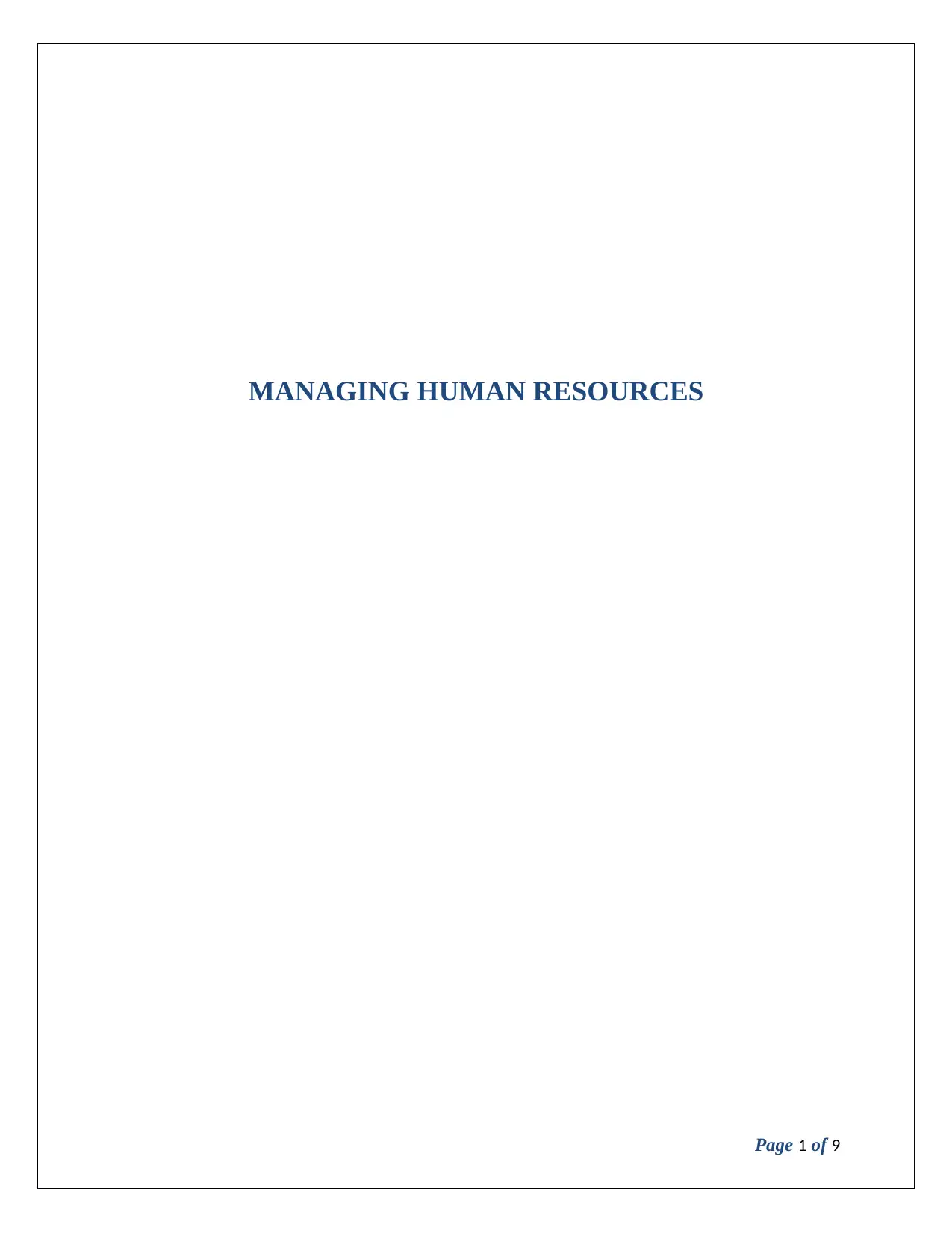
MANAGING HUMAN RESOURCES
Page 1 of 9
Page 1 of 9
Secure Best Marks with AI Grader
Need help grading? Try our AI Grader for instant feedback on your assignments.
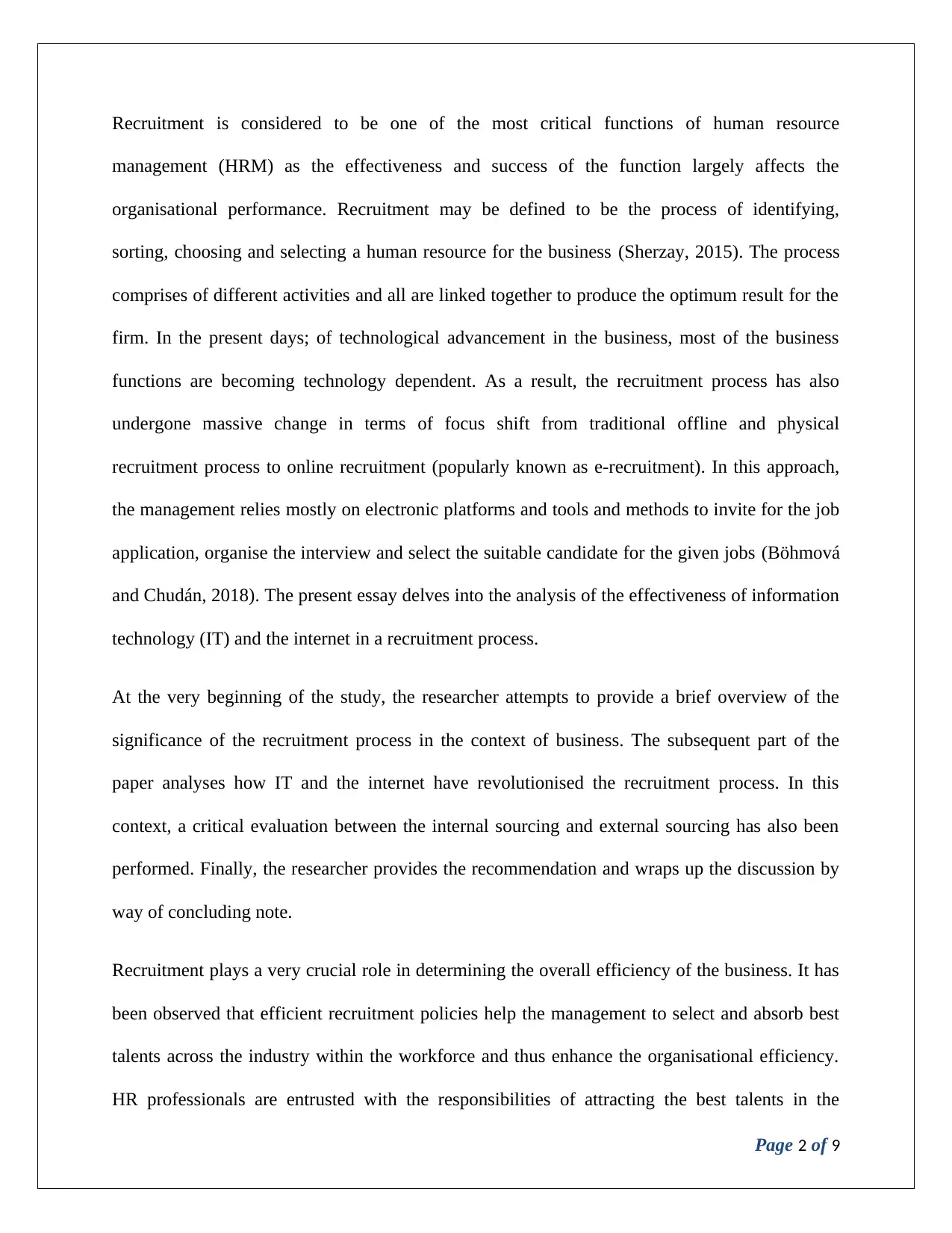
Recruitment is considered to be one of the most critical functions of human resource
management (HRM) as the effectiveness and success of the function largely affects the
organisational performance. Recruitment may be defined to be the process of identifying,
sorting, choosing and selecting a human resource for the business (Sherzay, 2015). The process
comprises of different activities and all are linked together to produce the optimum result for the
firm. In the present days; of technological advancement in the business, most of the business
functions are becoming technology dependent. As a result, the recruitment process has also
undergone massive change in terms of focus shift from traditional offline and physical
recruitment process to online recruitment (popularly known as e-recruitment). In this approach,
the management relies mostly on electronic platforms and tools and methods to invite for the job
application, organise the interview and select the suitable candidate for the given jobs (Böhmová
and Chudán, 2018). The present essay delves into the analysis of the effectiveness of information
technology (IT) and the internet in a recruitment process.
At the very beginning of the study, the researcher attempts to provide a brief overview of the
significance of the recruitment process in the context of business. The subsequent part of the
paper analyses how IT and the internet have revolutionised the recruitment process. In this
context, a critical evaluation between the internal sourcing and external sourcing has also been
performed. Finally, the researcher provides the recommendation and wraps up the discussion by
way of concluding note.
Recruitment plays a very crucial role in determining the overall efficiency of the business. It has
been observed that efficient recruitment policies help the management to select and absorb best
talents across the industry within the workforce and thus enhance the organisational efficiency.
HR professionals are entrusted with the responsibilities of attracting the best talents in the
Page 2 of 9
management (HRM) as the effectiveness and success of the function largely affects the
organisational performance. Recruitment may be defined to be the process of identifying,
sorting, choosing and selecting a human resource for the business (Sherzay, 2015). The process
comprises of different activities and all are linked together to produce the optimum result for the
firm. In the present days; of technological advancement in the business, most of the business
functions are becoming technology dependent. As a result, the recruitment process has also
undergone massive change in terms of focus shift from traditional offline and physical
recruitment process to online recruitment (popularly known as e-recruitment). In this approach,
the management relies mostly on electronic platforms and tools and methods to invite for the job
application, organise the interview and select the suitable candidate for the given jobs (Böhmová
and Chudán, 2018). The present essay delves into the analysis of the effectiveness of information
technology (IT) and the internet in a recruitment process.
At the very beginning of the study, the researcher attempts to provide a brief overview of the
significance of the recruitment process in the context of business. The subsequent part of the
paper analyses how IT and the internet have revolutionised the recruitment process. In this
context, a critical evaluation between the internal sourcing and external sourcing has also been
performed. Finally, the researcher provides the recommendation and wraps up the discussion by
way of concluding note.
Recruitment plays a very crucial role in determining the overall efficiency of the business. It has
been observed that efficient recruitment policies help the management to select and absorb best
talents across the industry within the workforce and thus enhance the organisational efficiency.
HR professionals are entrusted with the responsibilities of attracting the best talents in the
Page 2 of 9
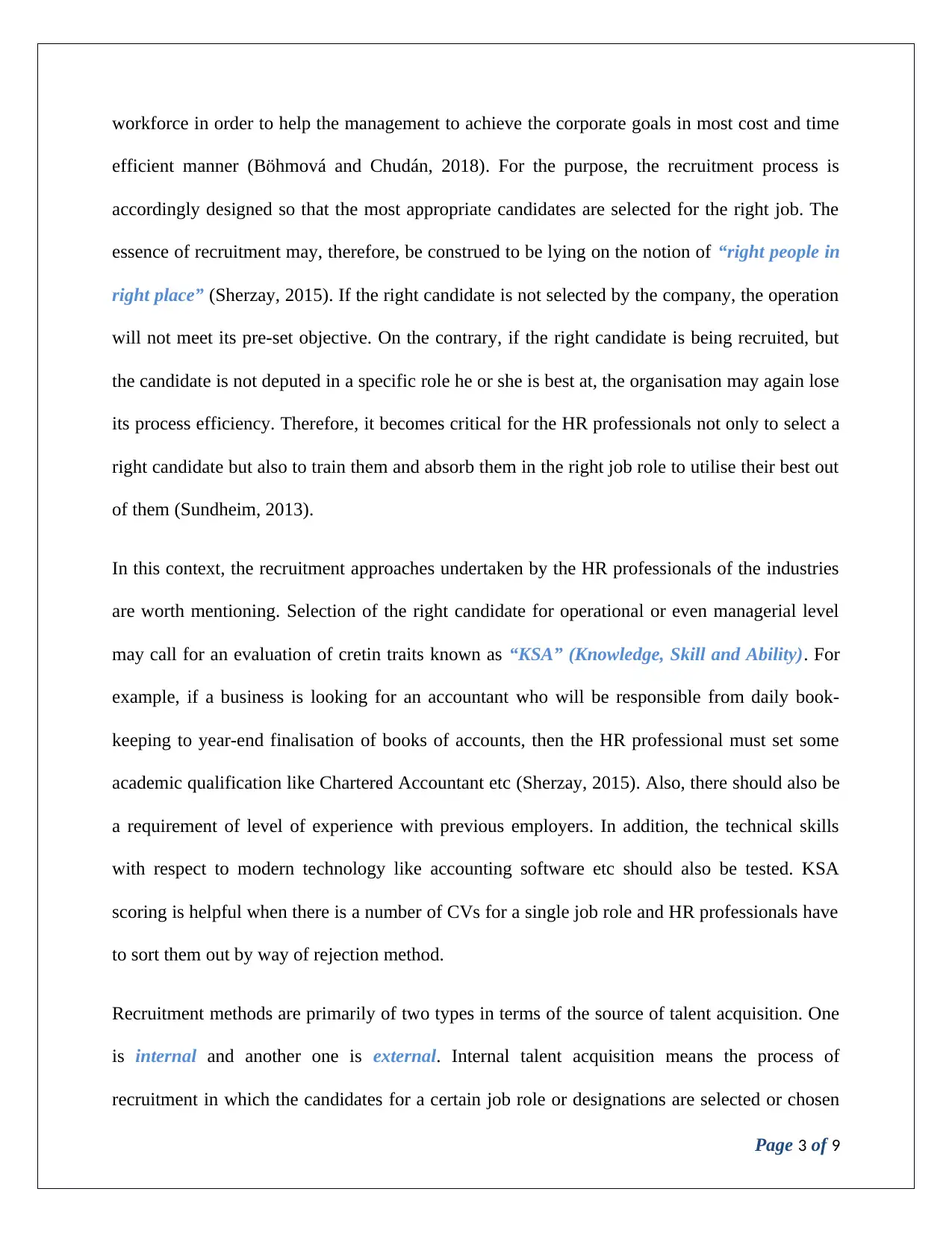
workforce in order to help the management to achieve the corporate goals in most cost and time
efficient manner (Böhmová and Chudán, 2018). For the purpose, the recruitment process is
accordingly designed so that the most appropriate candidates are selected for the right job. The
essence of recruitment may, therefore, be construed to be lying on the notion of “right people in
right place” (Sherzay, 2015). If the right candidate is not selected by the company, the operation
will not meet its pre-set objective. On the contrary, if the right candidate is being recruited, but
the candidate is not deputed in a specific role he or she is best at, the organisation may again lose
its process efficiency. Therefore, it becomes critical for the HR professionals not only to select a
right candidate but also to train them and absorb them in the right job role to utilise their best out
of them (Sundheim, 2013).
In this context, the recruitment approaches undertaken by the HR professionals of the industries
are worth mentioning. Selection of the right candidate for operational or even managerial level
may call for an evaluation of cretin traits known as “KSA” (Knowledge, Skill and Ability). For
example, if a business is looking for an accountant who will be responsible from daily book-
keeping to year-end finalisation of books of accounts, then the HR professional must set some
academic qualification like Chartered Accountant etc (Sherzay, 2015). Also, there should also be
a requirement of level of experience with previous employers. In addition, the technical skills
with respect to modern technology like accounting software etc should also be tested. KSA
scoring is helpful when there is a number of CVs for a single job role and HR professionals have
to sort them out by way of rejection method.
Recruitment methods are primarily of two types in terms of the source of talent acquisition. One
is internal and another one is external. Internal talent acquisition means the process of
recruitment in which the candidates for a certain job role or designations are selected or chosen
Page 3 of 9
efficient manner (Böhmová and Chudán, 2018). For the purpose, the recruitment process is
accordingly designed so that the most appropriate candidates are selected for the right job. The
essence of recruitment may, therefore, be construed to be lying on the notion of “right people in
right place” (Sherzay, 2015). If the right candidate is not selected by the company, the operation
will not meet its pre-set objective. On the contrary, if the right candidate is being recruited, but
the candidate is not deputed in a specific role he or she is best at, the organisation may again lose
its process efficiency. Therefore, it becomes critical for the HR professionals not only to select a
right candidate but also to train them and absorb them in the right job role to utilise their best out
of them (Sundheim, 2013).
In this context, the recruitment approaches undertaken by the HR professionals of the industries
are worth mentioning. Selection of the right candidate for operational or even managerial level
may call for an evaluation of cretin traits known as “KSA” (Knowledge, Skill and Ability). For
example, if a business is looking for an accountant who will be responsible from daily book-
keeping to year-end finalisation of books of accounts, then the HR professional must set some
academic qualification like Chartered Accountant etc (Sherzay, 2015). Also, there should also be
a requirement of level of experience with previous employers. In addition, the technical skills
with respect to modern technology like accounting software etc should also be tested. KSA
scoring is helpful when there is a number of CVs for a single job role and HR professionals have
to sort them out by way of rejection method.
Recruitment methods are primarily of two types in terms of the source of talent acquisition. One
is internal and another one is external. Internal talent acquisition means the process of
recruitment in which the candidates for a certain job role or designations are selected or chosen
Page 3 of 9
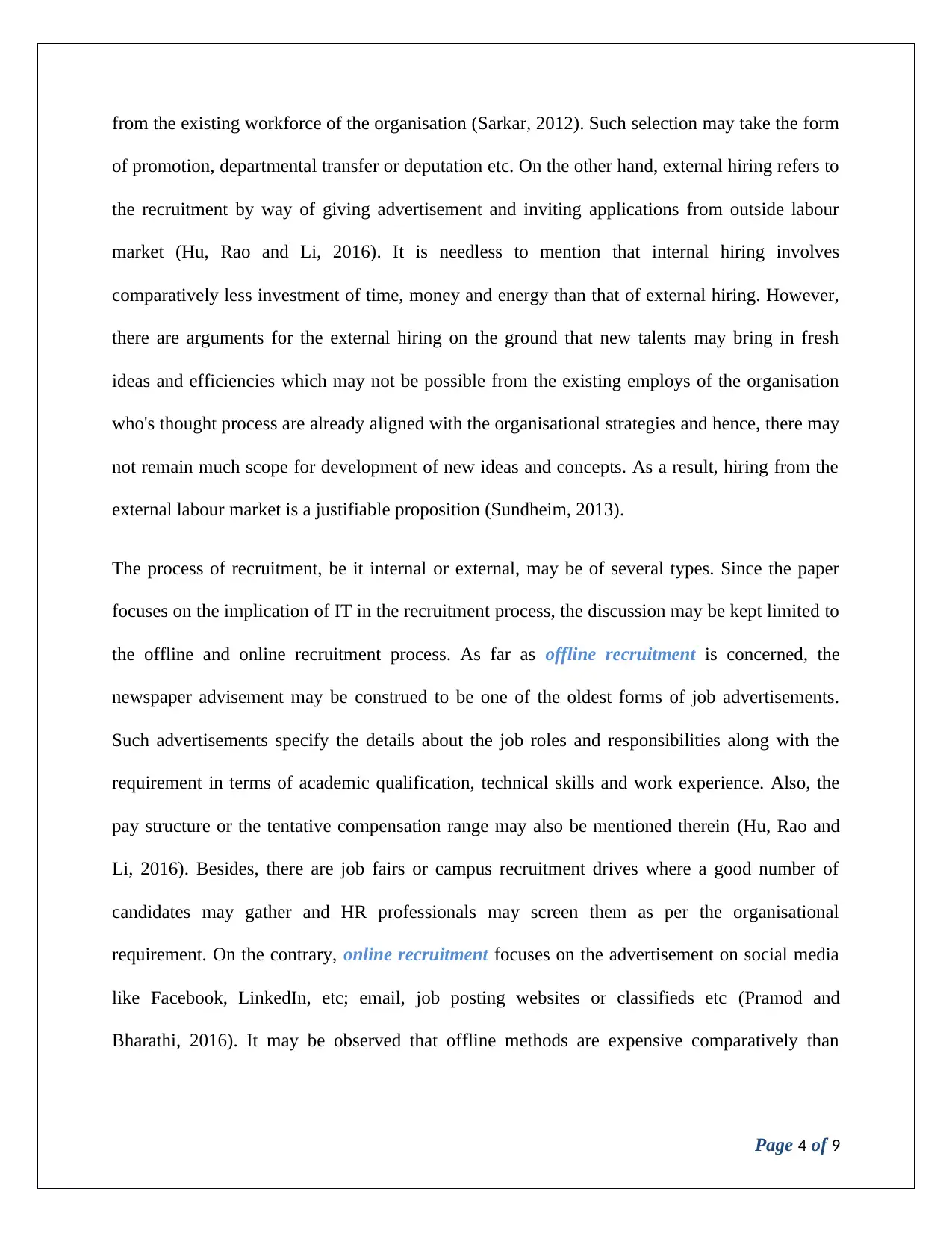
from the existing workforce of the organisation (Sarkar, 2012). Such selection may take the form
of promotion, departmental transfer or deputation etc. On the other hand, external hiring refers to
the recruitment by way of giving advertisement and inviting applications from outside labour
market (Hu, Rao and Li, 2016). It is needless to mention that internal hiring involves
comparatively less investment of time, money and energy than that of external hiring. However,
there are arguments for the external hiring on the ground that new talents may bring in fresh
ideas and efficiencies which may not be possible from the existing employs of the organisation
who's thought process are already aligned with the organisational strategies and hence, there may
not remain much scope for development of new ideas and concepts. As a result, hiring from the
external labour market is a justifiable proposition (Sundheim, 2013).
The process of recruitment, be it internal or external, may be of several types. Since the paper
focuses on the implication of IT in the recruitment process, the discussion may be kept limited to
the offline and online recruitment process. As far as offline recruitment is concerned, the
newspaper advisement may be construed to be one of the oldest forms of job advertisements.
Such advertisements specify the details about the job roles and responsibilities along with the
requirement in terms of academic qualification, technical skills and work experience. Also, the
pay structure or the tentative compensation range may also be mentioned therein (Hu, Rao and
Li, 2016). Besides, there are job fairs or campus recruitment drives where a good number of
candidates may gather and HR professionals may screen them as per the organisational
requirement. On the contrary, online recruitment focuses on the advertisement on social media
like Facebook, LinkedIn, etc; email, job posting websites or classifieds etc (Pramod and
Bharathi, 2016). It may be observed that offline methods are expensive comparatively than
Page 4 of 9
of promotion, departmental transfer or deputation etc. On the other hand, external hiring refers to
the recruitment by way of giving advertisement and inviting applications from outside labour
market (Hu, Rao and Li, 2016). It is needless to mention that internal hiring involves
comparatively less investment of time, money and energy than that of external hiring. However,
there are arguments for the external hiring on the ground that new talents may bring in fresh
ideas and efficiencies which may not be possible from the existing employs of the organisation
who's thought process are already aligned with the organisational strategies and hence, there may
not remain much scope for development of new ideas and concepts. As a result, hiring from the
external labour market is a justifiable proposition (Sundheim, 2013).
The process of recruitment, be it internal or external, may be of several types. Since the paper
focuses on the implication of IT in the recruitment process, the discussion may be kept limited to
the offline and online recruitment process. As far as offline recruitment is concerned, the
newspaper advisement may be construed to be one of the oldest forms of job advertisements.
Such advertisements specify the details about the job roles and responsibilities along with the
requirement in terms of academic qualification, technical skills and work experience. Also, the
pay structure or the tentative compensation range may also be mentioned therein (Hu, Rao and
Li, 2016). Besides, there are job fairs or campus recruitment drives where a good number of
candidates may gather and HR professionals may screen them as per the organisational
requirement. On the contrary, online recruitment focuses on the advertisement on social media
like Facebook, LinkedIn, etc; email, job posting websites or classifieds etc (Pramod and
Bharathi, 2016). It may be observed that offline methods are expensive comparatively than
Page 4 of 9
Secure Best Marks with AI Grader
Need help grading? Try our AI Grader for instant feedback on your assignments.
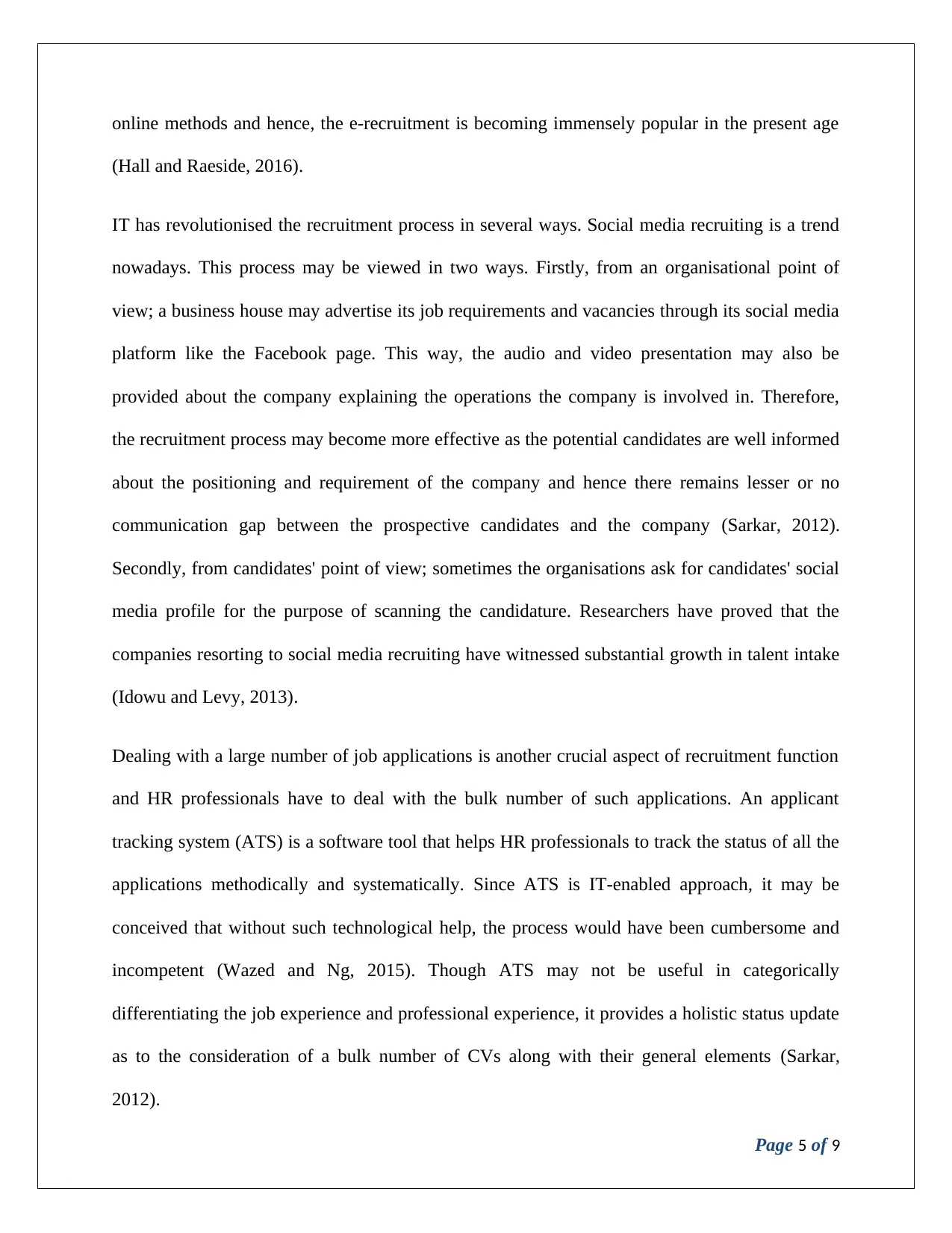
online methods and hence, the e-recruitment is becoming immensely popular in the present age
(Hall and Raeside, 2016).
IT has revolutionised the recruitment process in several ways. Social media recruiting is a trend
nowadays. This process may be viewed in two ways. Firstly, from an organisational point of
view; a business house may advertise its job requirements and vacancies through its social media
platform like the Facebook page. This way, the audio and video presentation may also be
provided about the company explaining the operations the company is involved in. Therefore,
the recruitment process may become more effective as the potential candidates are well informed
about the positioning and requirement of the company and hence there remains lesser or no
communication gap between the prospective candidates and the company (Sarkar, 2012).
Secondly, from candidates' point of view; sometimes the organisations ask for candidates' social
media profile for the purpose of scanning the candidature. Researchers have proved that the
companies resorting to social media recruiting have witnessed substantial growth in talent intake
(Idowu and Levy, 2013).
Dealing with a large number of job applications is another crucial aspect of recruitment function
and HR professionals have to deal with the bulk number of such applications. An applicant
tracking system (ATS) is a software tool that helps HR professionals to track the status of all the
applications methodically and systematically. Since ATS is IT-enabled approach, it may be
conceived that without such technological help, the process would have been cumbersome and
incompetent (Wazed and Ng, 2015). Though ATS may not be useful in categorically
differentiating the job experience and professional experience, it provides a holistic status update
as to the consideration of a bulk number of CVs along with their general elements (Sarkar,
2012).
Page 5 of 9
(Hall and Raeside, 2016).
IT has revolutionised the recruitment process in several ways. Social media recruiting is a trend
nowadays. This process may be viewed in two ways. Firstly, from an organisational point of
view; a business house may advertise its job requirements and vacancies through its social media
platform like the Facebook page. This way, the audio and video presentation may also be
provided about the company explaining the operations the company is involved in. Therefore,
the recruitment process may become more effective as the potential candidates are well informed
about the positioning and requirement of the company and hence there remains lesser or no
communication gap between the prospective candidates and the company (Sarkar, 2012).
Secondly, from candidates' point of view; sometimes the organisations ask for candidates' social
media profile for the purpose of scanning the candidature. Researchers have proved that the
companies resorting to social media recruiting have witnessed substantial growth in talent intake
(Idowu and Levy, 2013).
Dealing with a large number of job applications is another crucial aspect of recruitment function
and HR professionals have to deal with the bulk number of such applications. An applicant
tracking system (ATS) is a software tool that helps HR professionals to track the status of all the
applications methodically and systematically. Since ATS is IT-enabled approach, it may be
conceived that without such technological help, the process would have been cumbersome and
incompetent (Wazed and Ng, 2015). Though ATS may not be useful in categorically
differentiating the job experience and professional experience, it provides a holistic status update
as to the consideration of a bulk number of CVs along with their general elements (Sarkar,
2012).
Page 5 of 9
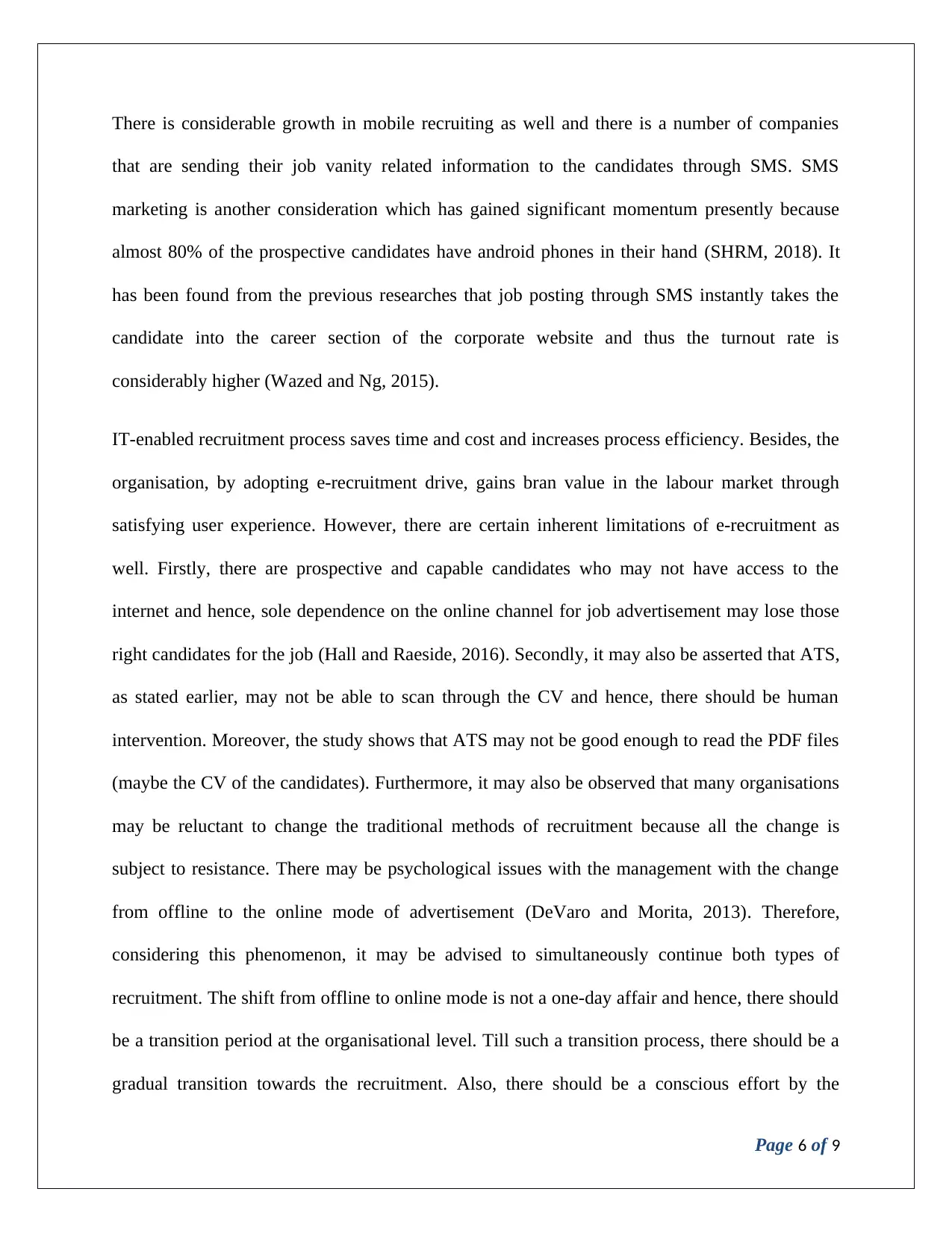
There is considerable growth in mobile recruiting as well and there is a number of companies
that are sending their job vanity related information to the candidates through SMS. SMS
marketing is another consideration which has gained significant momentum presently because
almost 80% of the prospective candidates have android phones in their hand (SHRM, 2018). It
has been found from the previous researches that job posting through SMS instantly takes the
candidate into the career section of the corporate website and thus the turnout rate is
considerably higher (Wazed and Ng, 2015).
IT-enabled recruitment process saves time and cost and increases process efficiency. Besides, the
organisation, by adopting e-recruitment drive, gains bran value in the labour market through
satisfying user experience. However, there are certain inherent limitations of e-recruitment as
well. Firstly, there are prospective and capable candidates who may not have access to the
internet and hence, sole dependence on the online channel for job advertisement may lose those
right candidates for the job (Hall and Raeside, 2016). Secondly, it may also be asserted that ATS,
as stated earlier, may not be able to scan through the CV and hence, there should be human
intervention. Moreover, the study shows that ATS may not be good enough to read the PDF files
(maybe the CV of the candidates). Furthermore, it may also be observed that many organisations
may be reluctant to change the traditional methods of recruitment because all the change is
subject to resistance. There may be psychological issues with the management with the change
from offline to the online mode of advertisement (DeVaro and Morita, 2013). Therefore,
considering this phenomenon, it may be advised to simultaneously continue both types of
recruitment. The shift from offline to online mode is not a one-day affair and hence, there should
be a transition period at the organisational level. Till such a transition process, there should be a
gradual transition towards the recruitment. Also, there should be a conscious effort by the
Page 6 of 9
that are sending their job vanity related information to the candidates through SMS. SMS
marketing is another consideration which has gained significant momentum presently because
almost 80% of the prospective candidates have android phones in their hand (SHRM, 2018). It
has been found from the previous researches that job posting through SMS instantly takes the
candidate into the career section of the corporate website and thus the turnout rate is
considerably higher (Wazed and Ng, 2015).
IT-enabled recruitment process saves time and cost and increases process efficiency. Besides, the
organisation, by adopting e-recruitment drive, gains bran value in the labour market through
satisfying user experience. However, there are certain inherent limitations of e-recruitment as
well. Firstly, there are prospective and capable candidates who may not have access to the
internet and hence, sole dependence on the online channel for job advertisement may lose those
right candidates for the job (Hall and Raeside, 2016). Secondly, it may also be asserted that ATS,
as stated earlier, may not be able to scan through the CV and hence, there should be human
intervention. Moreover, the study shows that ATS may not be good enough to read the PDF files
(maybe the CV of the candidates). Furthermore, it may also be observed that many organisations
may be reluctant to change the traditional methods of recruitment because all the change is
subject to resistance. There may be psychological issues with the management with the change
from offline to the online mode of advertisement (DeVaro and Morita, 2013). Therefore,
considering this phenomenon, it may be advised to simultaneously continue both types of
recruitment. The shift from offline to online mode is not a one-day affair and hence, there should
be a transition period at the organisational level. Till such a transition process, there should be a
gradual transition towards the recruitment. Also, there should be a conscious effort by the
Page 6 of 9
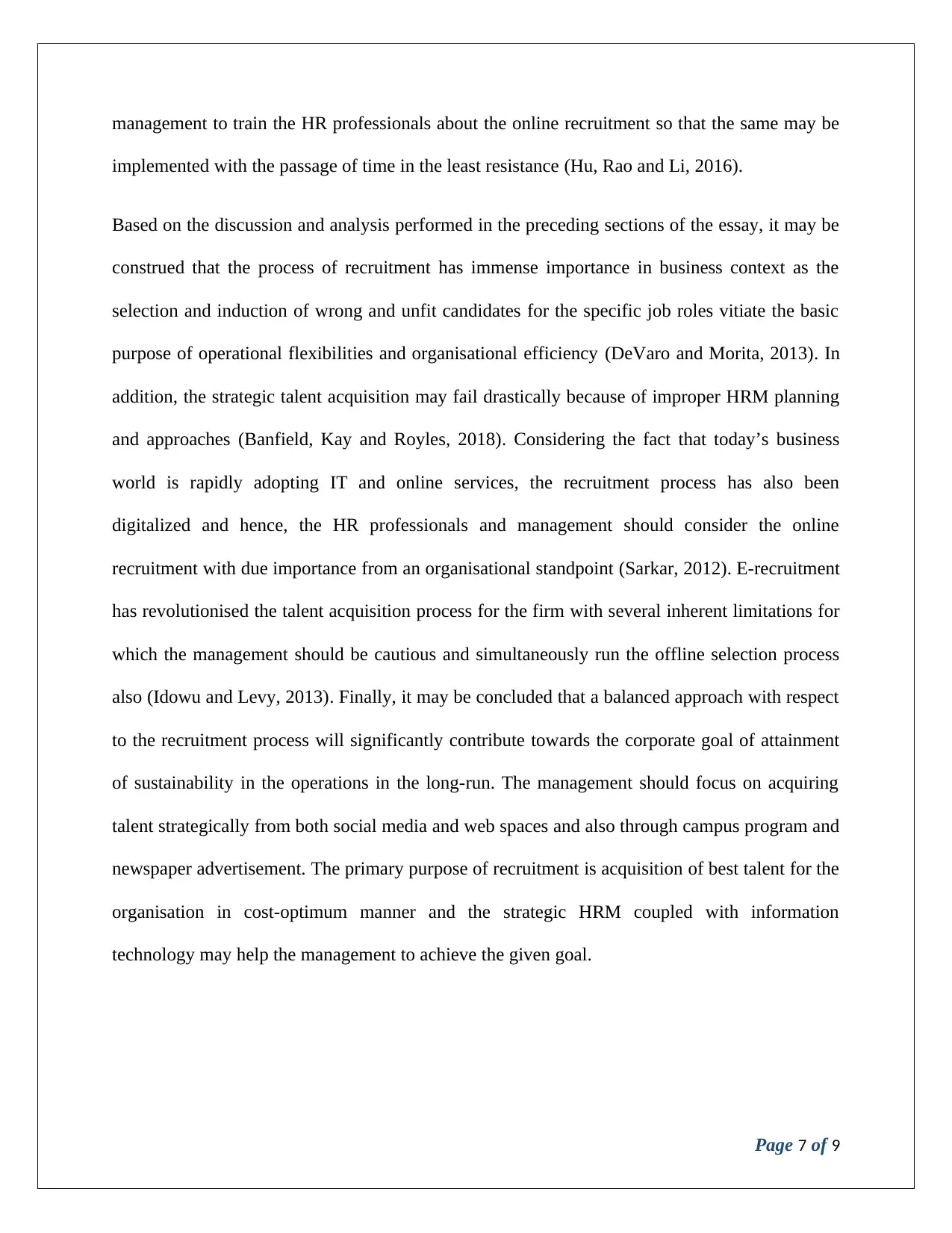
management to train the HR professionals about the online recruitment so that the same may be
implemented with the passage of time in the least resistance (Hu, Rao and Li, 2016).
Based on the discussion and analysis performed in the preceding sections of the essay, it may be
construed that the process of recruitment has immense importance in business context as the
selection and induction of wrong and unfit candidates for the specific job roles vitiate the basic
purpose of operational flexibilities and organisational efficiency (DeVaro and Morita, 2013). In
addition, the strategic talent acquisition may fail drastically because of improper HRM planning
and approaches (Banfield, Kay and Royles, 2018). Considering the fact that today’s business
world is rapidly adopting IT and online services, the recruitment process has also been
digitalized and hence, the HR professionals and management should consider the online
recruitment with due importance from an organisational standpoint (Sarkar, 2012). E-recruitment
has revolutionised the talent acquisition process for the firm with several inherent limitations for
which the management should be cautious and simultaneously run the offline selection process
also (Idowu and Levy, 2013). Finally, it may be concluded that a balanced approach with respect
to the recruitment process will significantly contribute towards the corporate goal of attainment
of sustainability in the operations in the long-run. The management should focus on acquiring
talent strategically from both social media and web spaces and also through campus program and
newspaper advertisement. The primary purpose of recruitment is acquisition of best talent for the
organisation in cost-optimum manner and the strategic HRM coupled with information
technology may help the management to achieve the given goal.
Page 7 of 9
implemented with the passage of time in the least resistance (Hu, Rao and Li, 2016).
Based on the discussion and analysis performed in the preceding sections of the essay, it may be
construed that the process of recruitment has immense importance in business context as the
selection and induction of wrong and unfit candidates for the specific job roles vitiate the basic
purpose of operational flexibilities and organisational efficiency (DeVaro and Morita, 2013). In
addition, the strategic talent acquisition may fail drastically because of improper HRM planning
and approaches (Banfield, Kay and Royles, 2018). Considering the fact that today’s business
world is rapidly adopting IT and online services, the recruitment process has also been
digitalized and hence, the HR professionals and management should consider the online
recruitment with due importance from an organisational standpoint (Sarkar, 2012). E-recruitment
has revolutionised the talent acquisition process for the firm with several inherent limitations for
which the management should be cautious and simultaneously run the offline selection process
also (Idowu and Levy, 2013). Finally, it may be concluded that a balanced approach with respect
to the recruitment process will significantly contribute towards the corporate goal of attainment
of sustainability in the operations in the long-run. The management should focus on acquiring
talent strategically from both social media and web spaces and also through campus program and
newspaper advertisement. The primary purpose of recruitment is acquisition of best talent for the
organisation in cost-optimum manner and the strategic HRM coupled with information
technology may help the management to achieve the given goal.
Page 7 of 9
Paraphrase This Document
Need a fresh take? Get an instant paraphrase of this document with our AI Paraphraser
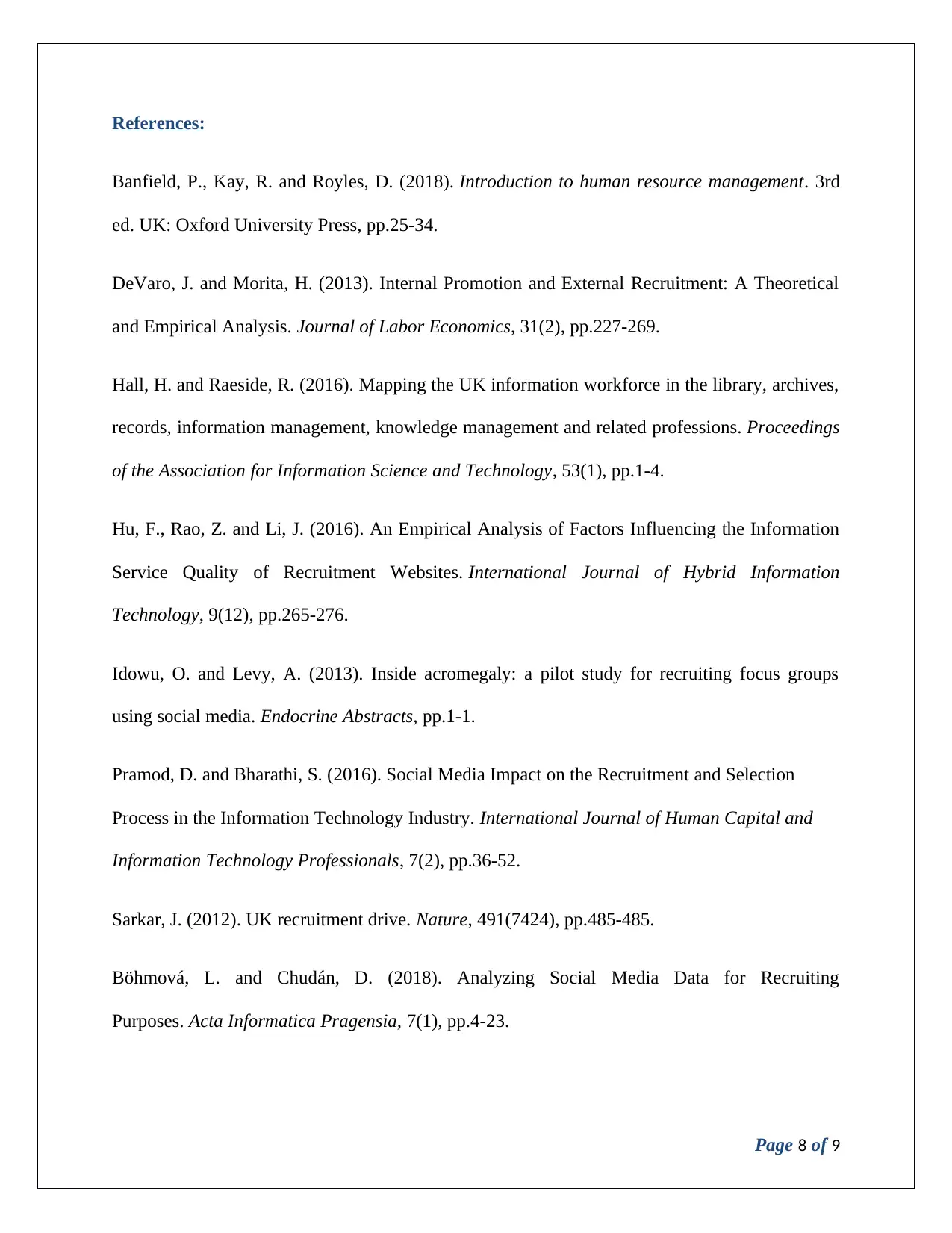
References:
Banfield, P., Kay, R. and Royles, D. (2018). Introduction to human resource management. 3rd
ed. UK: Oxford University Press, pp.25-34.
DeVaro, J. and Morita, H. (2013). Internal Promotion and External Recruitment: A Theoretical
and Empirical Analysis. Journal of Labor Economics, 31(2), pp.227-269.
Hall, H. and Raeside, R. (2016). Mapping the UK information workforce in the library, archives,
records, information management, knowledge management and related professions. Proceedings
of the Association for Information Science and Technology, 53(1), pp.1-4.
Hu, F., Rao, Z. and Li, J. (2016). An Empirical Analysis of Factors Influencing the Information
Service Quality of Recruitment Websites. International Journal of Hybrid Information
Technology, 9(12), pp.265-276.
Idowu, O. and Levy, A. (2013). Inside acromegaly: a pilot study for recruiting focus groups
using social media. Endocrine Abstracts, pp.1-1.
Pramod, D. and Bharathi, S. (2016). Social Media Impact on the Recruitment and Selection
Process in the Information Technology Industry. International Journal of Human Capital and
Information Technology Professionals, 7(2), pp.36-52.
Sarkar, J. (2012). UK recruitment drive. Nature, 491(7424), pp.485-485.
Böhmová, L. and Chudán, D. (2018). Analyzing Social Media Data for Recruiting
Purposes. Acta Informatica Pragensia, 7(1), pp.4-23.
Page 8 of 9
Banfield, P., Kay, R. and Royles, D. (2018). Introduction to human resource management. 3rd
ed. UK: Oxford University Press, pp.25-34.
DeVaro, J. and Morita, H. (2013). Internal Promotion and External Recruitment: A Theoretical
and Empirical Analysis. Journal of Labor Economics, 31(2), pp.227-269.
Hall, H. and Raeside, R. (2016). Mapping the UK information workforce in the library, archives,
records, information management, knowledge management and related professions. Proceedings
of the Association for Information Science and Technology, 53(1), pp.1-4.
Hu, F., Rao, Z. and Li, J. (2016). An Empirical Analysis of Factors Influencing the Information
Service Quality of Recruitment Websites. International Journal of Hybrid Information
Technology, 9(12), pp.265-276.
Idowu, O. and Levy, A. (2013). Inside acromegaly: a pilot study for recruiting focus groups
using social media. Endocrine Abstracts, pp.1-1.
Pramod, D. and Bharathi, S. (2016). Social Media Impact on the Recruitment and Selection
Process in the Information Technology Industry. International Journal of Human Capital and
Information Technology Professionals, 7(2), pp.36-52.
Sarkar, J. (2012). UK recruitment drive. Nature, 491(7424), pp.485-485.
Böhmová, L. and Chudán, D. (2018). Analyzing Social Media Data for Recruiting
Purposes. Acta Informatica Pragensia, 7(1), pp.4-23.
Page 8 of 9
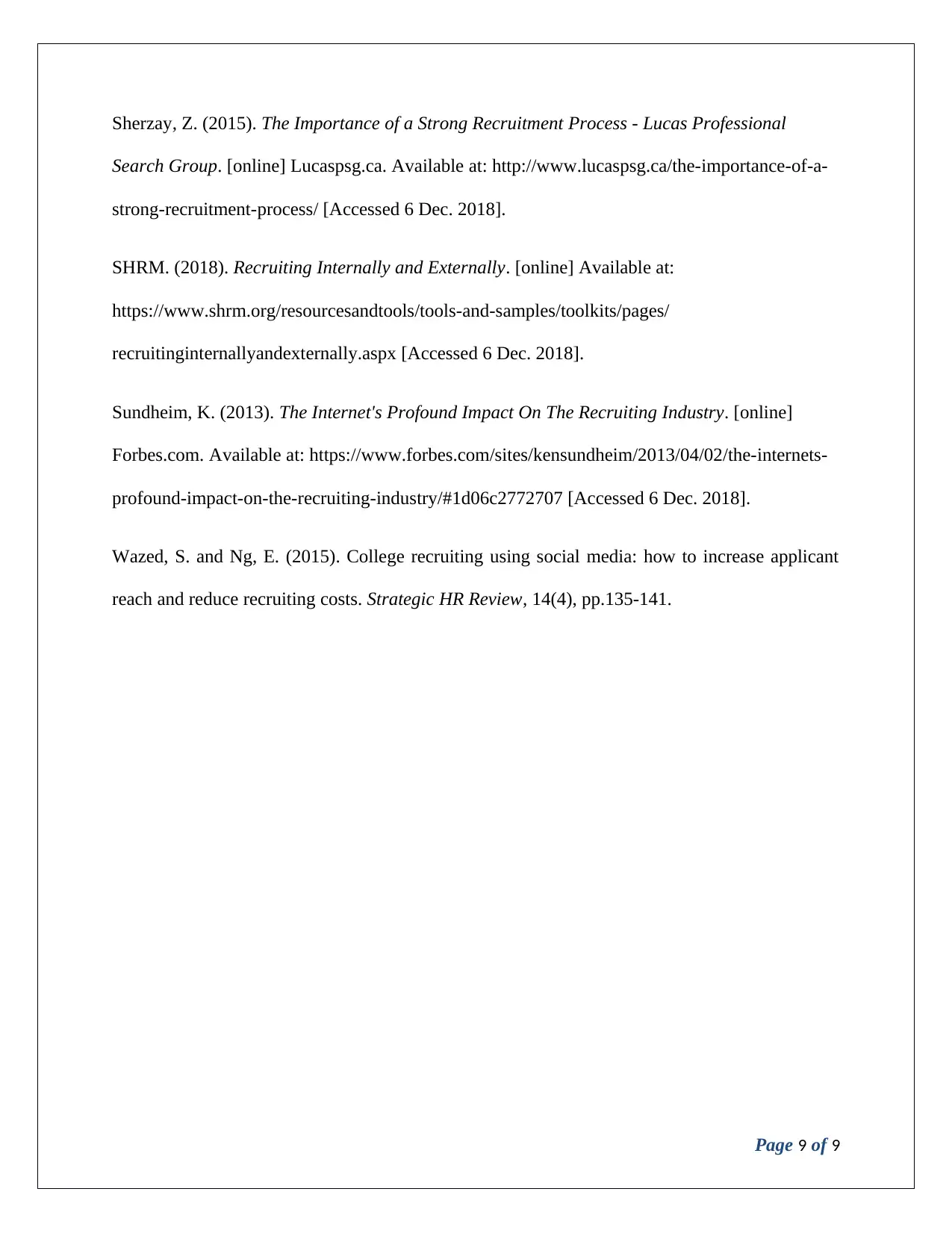
Sherzay, Z. (2015). The Importance of a Strong Recruitment Process - Lucas Professional
Search Group. [online] Lucaspsg.ca. Available at: http://www.lucaspsg.ca/the-importance-of-a-
strong-recruitment-process/ [Accessed 6 Dec. 2018].
SHRM. (2018). Recruiting Internally and Externally. [online] Available at:
https://www.shrm.org/resourcesandtools/tools-and-samples/toolkits/pages/
recruitinginternallyandexternally.aspx [Accessed 6 Dec. 2018].
Sundheim, K. (2013). The Internet's Profound Impact On The Recruiting Industry. [online]
Forbes.com. Available at: https://www.forbes.com/sites/kensundheim/2013/04/02/the-internets-
profound-impact-on-the-recruiting-industry/#1d06c2772707 [Accessed 6 Dec. 2018].
Wazed, S. and Ng, E. (2015). College recruiting using social media: how to increase applicant
reach and reduce recruiting costs. Strategic HR Review, 14(4), pp.135-141.
Page 9 of 9
Search Group. [online] Lucaspsg.ca. Available at: http://www.lucaspsg.ca/the-importance-of-a-
strong-recruitment-process/ [Accessed 6 Dec. 2018].
SHRM. (2018). Recruiting Internally and Externally. [online] Available at:
https://www.shrm.org/resourcesandtools/tools-and-samples/toolkits/pages/
recruitinginternallyandexternally.aspx [Accessed 6 Dec. 2018].
Sundheim, K. (2013). The Internet's Profound Impact On The Recruiting Industry. [online]
Forbes.com. Available at: https://www.forbes.com/sites/kensundheim/2013/04/02/the-internets-
profound-impact-on-the-recruiting-industry/#1d06c2772707 [Accessed 6 Dec. 2018].
Wazed, S. and Ng, E. (2015). College recruiting using social media: how to increase applicant
reach and reduce recruiting costs. Strategic HR Review, 14(4), pp.135-141.
Page 9 of 9
1 out of 9
Related Documents
Your All-in-One AI-Powered Toolkit for Academic Success.
+13062052269
info@desklib.com
Available 24*7 on WhatsApp / Email
![[object Object]](/_next/static/media/star-bottom.7253800d.svg)
Unlock your academic potential
© 2024 | Zucol Services PVT LTD | All rights reserved.





